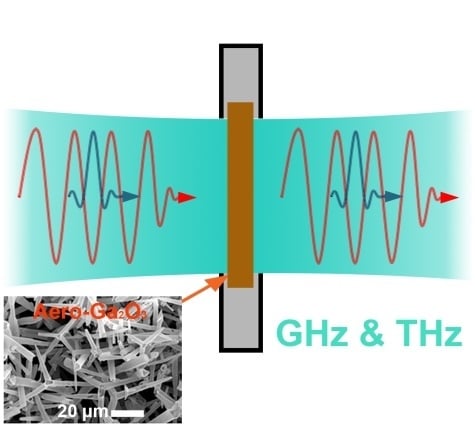Aero-Ga2O3 Nanomaterial Electromagnetically Transparent from Microwaves to Terahertz for Internet of Things Applications
Abstract
:1. Introduction
2. Materials and Methods
3. Results and Discussion
3.1. Structural Characterization of Aero-Ga2O3
3.2. Characterization of Aero-Ga2O3 at Microwaves.
3.3. Characterization of Aero-Ga2O3 in the Terahertz Region
4. Conclusions
Author Contributions
Funding
Conflicts of Interest
References
- Mani, G.S. Radome Materials. In Microwave Materials; Murthy, V.R.K., Sundaram, S., Viswanathan, B., Eds.; Springer: Berlin, Germany, 1994; pp. 200–239. [Google Scholar]
- Khatavkara, N.; Balasubramanian, K. Composite materials for supersonic aircraft radomes with ameliorated radio frequency transmission—A review. RCS Adv. 2016, 6, 6709–6718. [Google Scholar] [CrossRef]
- Dang, S.; Amin, O.; Shihada, B.; Alouini, M.-S. What should 6G be? Nat. Electron. 2020, 3, 20–29. [Google Scholar] [CrossRef] [Green Version]
- Asghari, P.; Rahmani, A.M.; Javadi, H.H.S. Internet of Things applications: A systematic review. Comput. Networks 2019, 148, 241–261. [Google Scholar] [CrossRef]
- Zhou, H.; Zhang, J.; Zhang, C.; Feng, Q.; Zhao, S.; Ma, P.; Hao, Y. A review of the most recent progresses of state-of-art gallium oxide power devices. J. Semicond. 2019, 40, 011803. [Google Scholar] [CrossRef]
- Pearton, S.J.; Yang, J.; Cary IV, P.H.; Ren, F.; Kim, J.; Tadjer, M.J.; Mastro, M.A. A review of Ga2O3 materials, processing, and devices. Appl. Phys. Rev. 2018, 5, 011301. [Google Scholar] [CrossRef] [Green Version]
- Xia, Z.; Xue, H.; Joishi, C.; McGlone, J.; Kalaricka, N.K.; Sohel, S.H.; Brenner, M.; Arehart, A.; Ringel, S.; Lodha, S.; et al. β-Ga2O3 delta-doped field-effecttransistors with current gain cutoff frequency of 27 GHz. IEEE Trans. El. Dev. 2019, 40, 1053–1055. [Google Scholar]
- Jakus, A.E.; Secor, E.B.; Rutz, A.L.; Jordan, S.W.; Hersam, M.C.; Shah, R.N. Three-dimensional printing of high-content graphene scaffolds for electronics and biomedical applications. ACS Nano 2015, 9, 4636–4648. [Google Scholar] [CrossRef] [PubMed]
- Paulowicz, I.; Hrkac, V.; Kaps, S.; Cretu, V.; Lupan, O.; Braniste, T.; Duppel, V.; Tiginyanu, I.; Kienle, L.; Adelung, R.; et al. Three-dimensional SnO2 nanowire networks for multifunctional applications: From high-temperature stretchable ceramics to ultraresponsive sensors. Adv. Electron. Mater. 2015, 1, 1500081. [Google Scholar] [CrossRef]
- Tiginyanu, I.; Braniste, T.; Smazna, D.; Deng, M.; Schutt, F.; Schuchardt, A.; Stevens-Kalceff, M.A.; Raevschi, S.; Schurmann, U.; Kienle, L.; et al. Self-organized and self-propelled aero-GaN with dual hydrophilic/hydrophobic behaviour. Nano Energy 2019, 56, 759–769. [Google Scholar] [CrossRef]
- Mishra, Y.K.; Kaps, S.; Schuchardt, A.; Paulowicz, I.; Jin, X.; Gedamu, D.; Freitag, S.; Claus, M.; Wille, S.; Kovalev, A.; et al. Fabrication of macroscopically flexible and highly porous 3D semiconductor networks from interpenetrating nanostructures by a simple flame transport approach. Part. Part. Syst. Charact. 2013, 30, 775. [Google Scholar] [CrossRef]
- Dragoman, M.; Ciobanu, V.; Shree, S.; Dragoman, D.; Braniste, T.; Raevschi, S.; Dinescu, A.; Sarua, A.; Mishra, Y.K.; Pugno, N.; et al. Sensing up to 40 atm using pressure-sensitive aero-GaN. Phys. Status Solidi RRL 2019, 13, 1900012. [Google Scholar] [CrossRef] [Green Version]
- Dragoman, M.; Braniste, T.; Iordanescu, S.; Aldrigo, M.; Raevschi, S.; Shree, S.; Adelung, R.; Tiginyanu, I. Electromagnetic interference shielding in X-band with aero-GaN. Nanotechnology 2019, 30, 34LT01. [Google Scholar] [CrossRef] [PubMed]
- Born, M.; Wolf, E. Principles of Optics, 7th (expanded) ed.; Cambridge University Press: Cambridge, UK, 2003. [Google Scholar]
- Zhang, X.; Huang, H.; Zhang, Y.; Liu, D.; Tong, N.; Lin, J.; Chen, L.; Zhang, Z.; Wang, X. Phase transition of two-dimensional β-Ga2O3 nanosheets from ultrathin γ-Ga2O3 nanosheets and their photocatalytic hydrogen evolution activities. ACS Omega 2018, 3, 14469–14476. [Google Scholar] [CrossRef] [PubMed] [Green Version]
- Bourque, J.L.; Biesingerb, M.C.; Baines, K.M. Chemical state determination of molecular gallium compounds using XPS. Dalton Trans. 2016, 45, 7678–7696. [Google Scholar] [CrossRef] [PubMed]
- Gibbon, J.T.; Jones, L.; Roberts, J.W.; Althobaiti, M.; Chalker, P.R.; Mitrovic, I.Z.; Dhanak, V.R. Band alignments at Ga2O3 heterojunction interfaces with Si and Ge. AIP Advances 2018, 8, 065011. [Google Scholar] [CrossRef]
- Huang, L.; Feng, Q.; Han, G.; Li, F.; Li, X.; Fang, L.; Xing, X.; Zhang, J.; Hao, Y. Comparison study of β-Ga2O3 photodetectors grown on sapphire at different oxygen pressures. IEEE Photonics J. 2017, 9, 2731625. [Google Scholar] [CrossRef]
- Son, H.; Choi, Y.-J.; Hwang, J.; Jeon, D.-W. Influence of post-annealing on properties of α-Ga2O3 epilayer grown by halide vapor phase epitaxy. ECS J. Solid State Sci. Technol. 2019, 8, Q3024. [Google Scholar] [CrossRef]
- Tak, B.R.; Dewan, S.; Goyal, A.; Pathak, R.; Gupta, V.; Kapoor, A.K.; Nagarajan, S.; Singh, R. Point defects induced work function modulation of β-Ga2O3. Appl. Surf. Sci. 2019, 465, 973–978. [Google Scholar] [CrossRef]
- Ritter, J.R.; Huso, J.; Dickens, P.T.; Varley, J.B.; Lynn, K.G.; McCluskey, M.D. Compensation and hydrogen passivation of magnesium acceptors in β-Ga2O3. Appl. Phys. Lett. 2018, 113, 052101. [Google Scholar] [CrossRef]
- Braniste, T.; Zhukov, S.; Dragoman, M.; Alyabyeva, L.; Ciobanu, V.; Aldrigo, M.; Dragoman, D.; Iordanescu, S.; Shree, S.; Raevschi, S.; et al. Terahertz shielding properties of aero-GaN. Semicond. Sci. Technol. 2019, 34, 12LT02. [Google Scholar] [CrossRef] [Green Version]
- Kozlov, G.V.; Volkov, A.A. Millimeter and Submillimeter Wave Spectroscopy of Solids; Gruner, G., Ed.; Springer-Verlag: Berlin, Germany, 1997; p. 51. [Google Scholar]
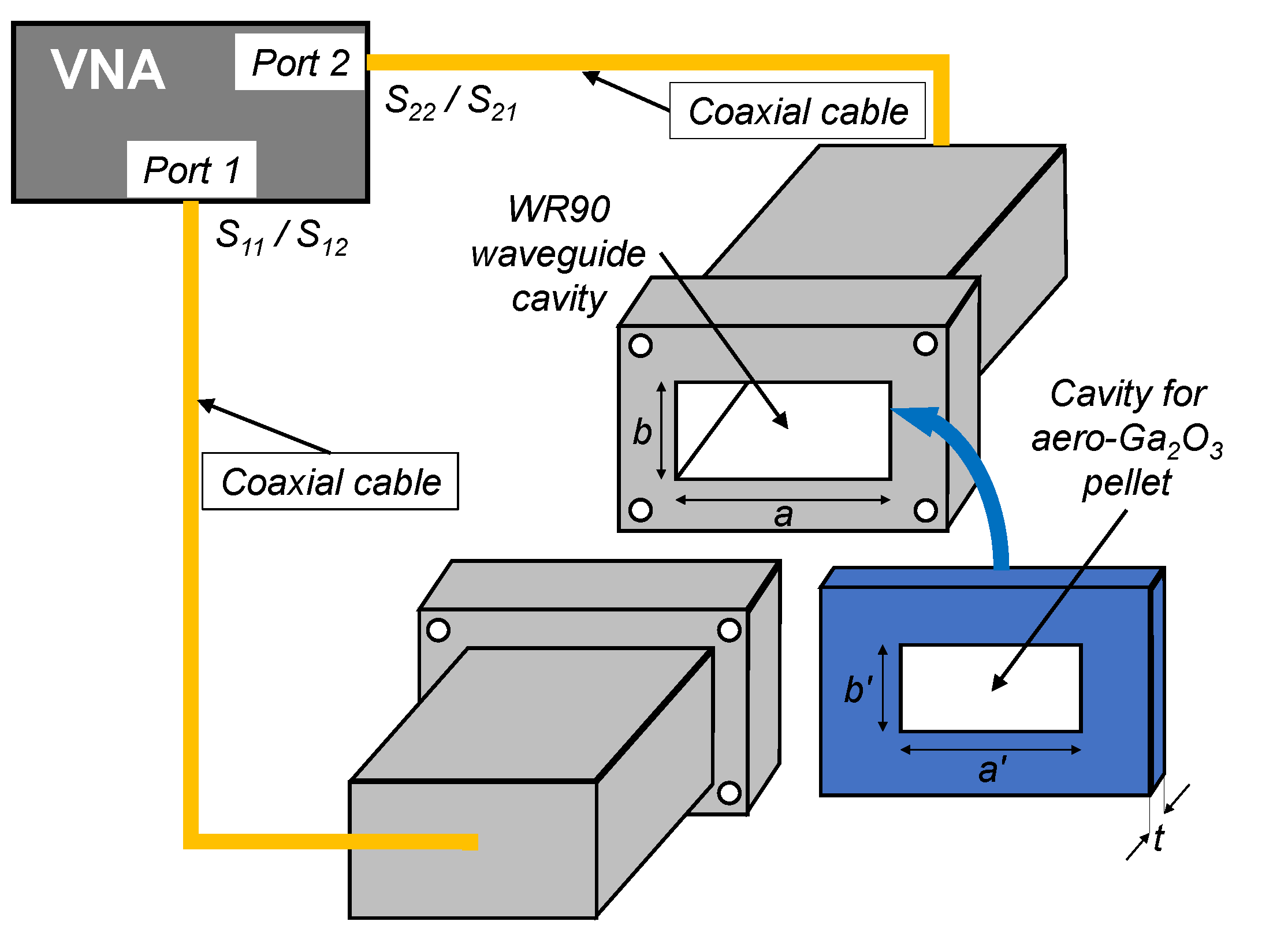

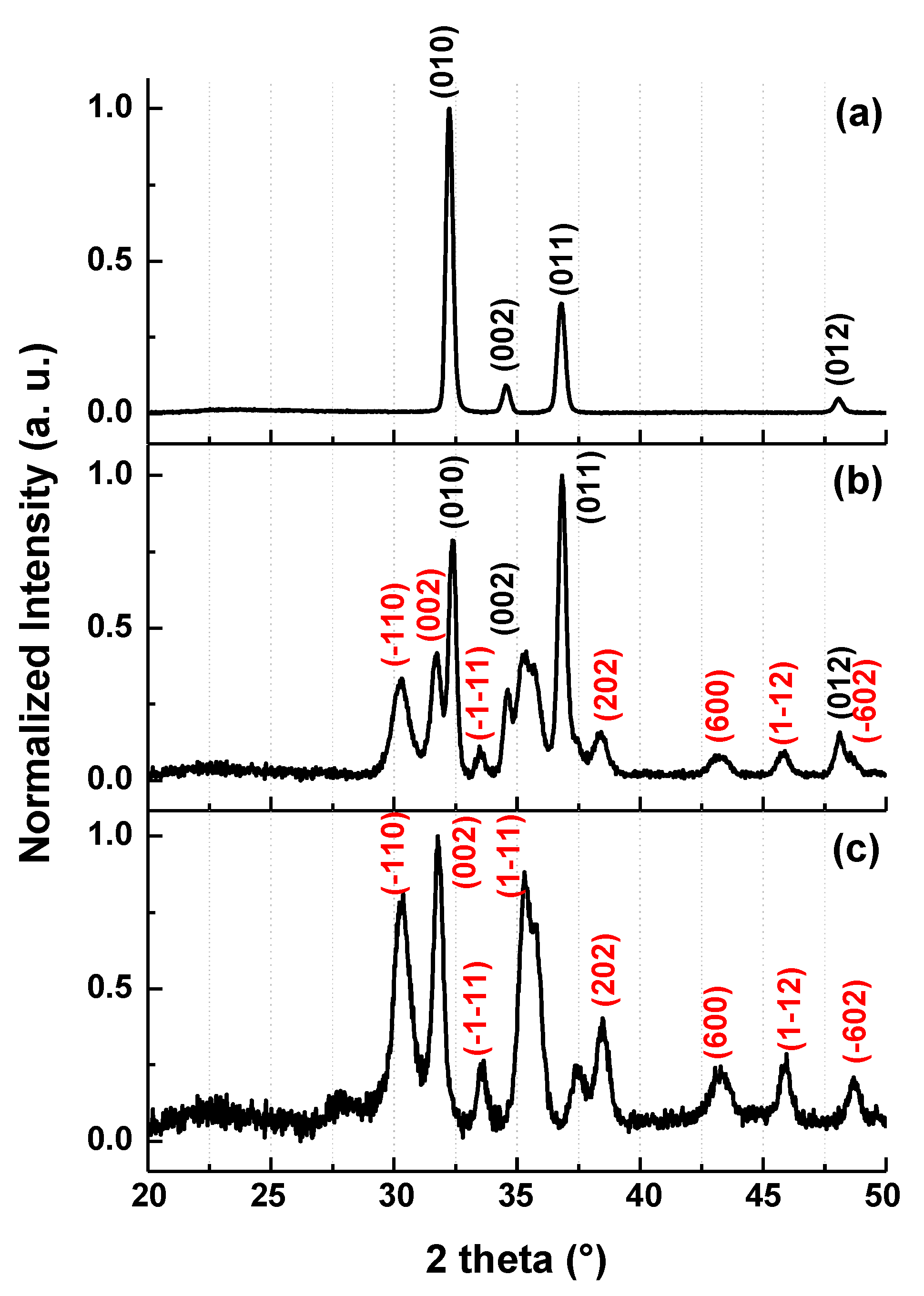
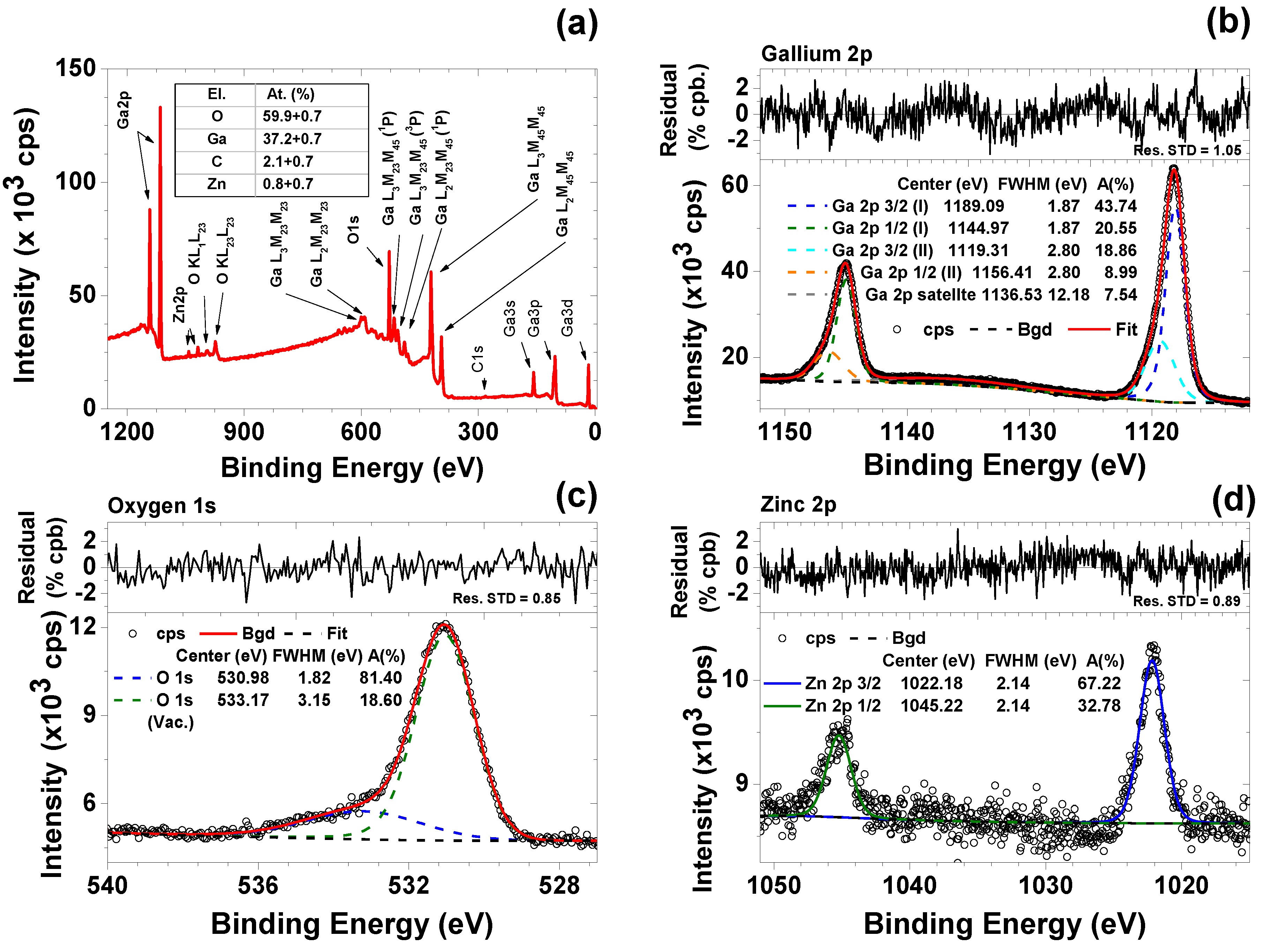

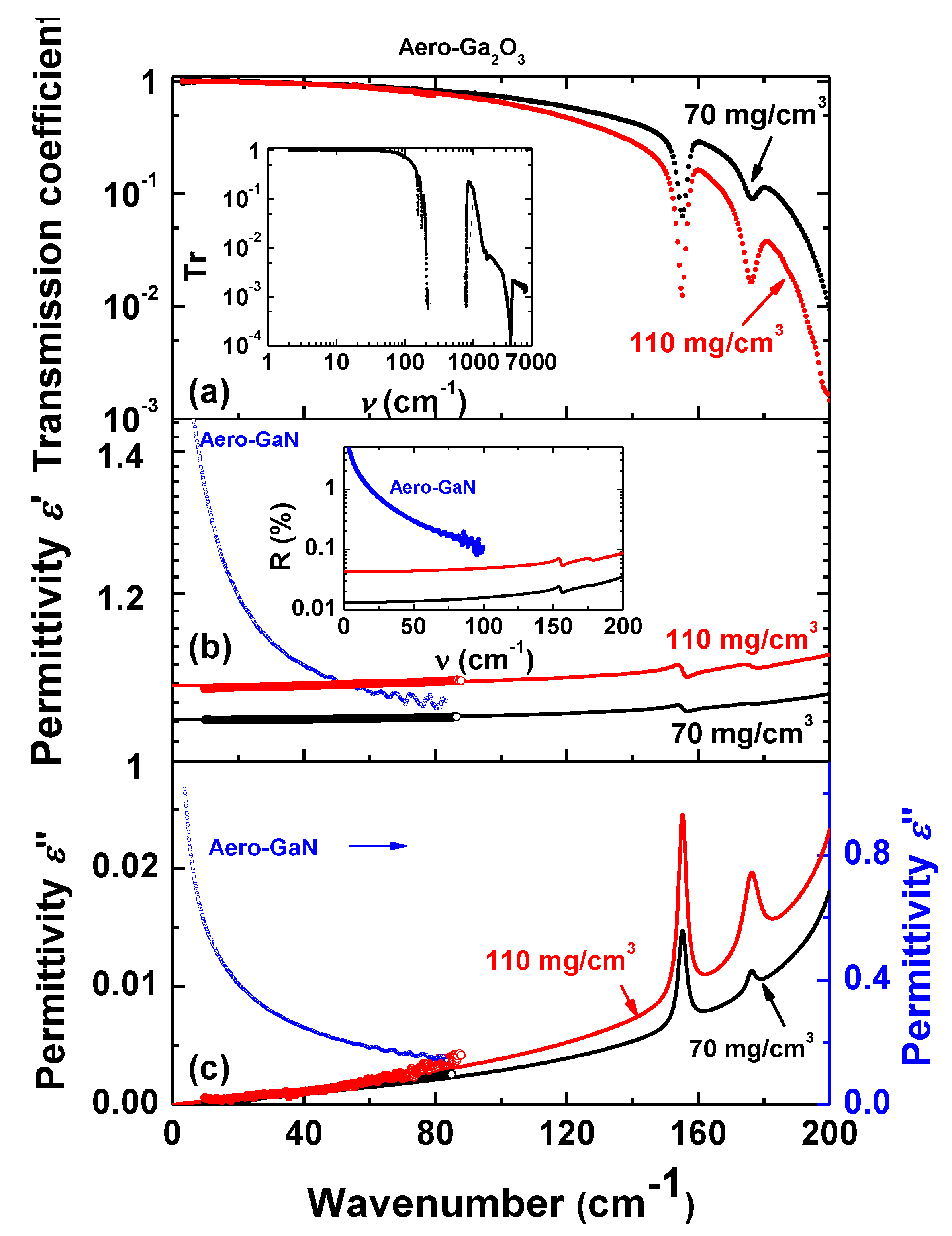
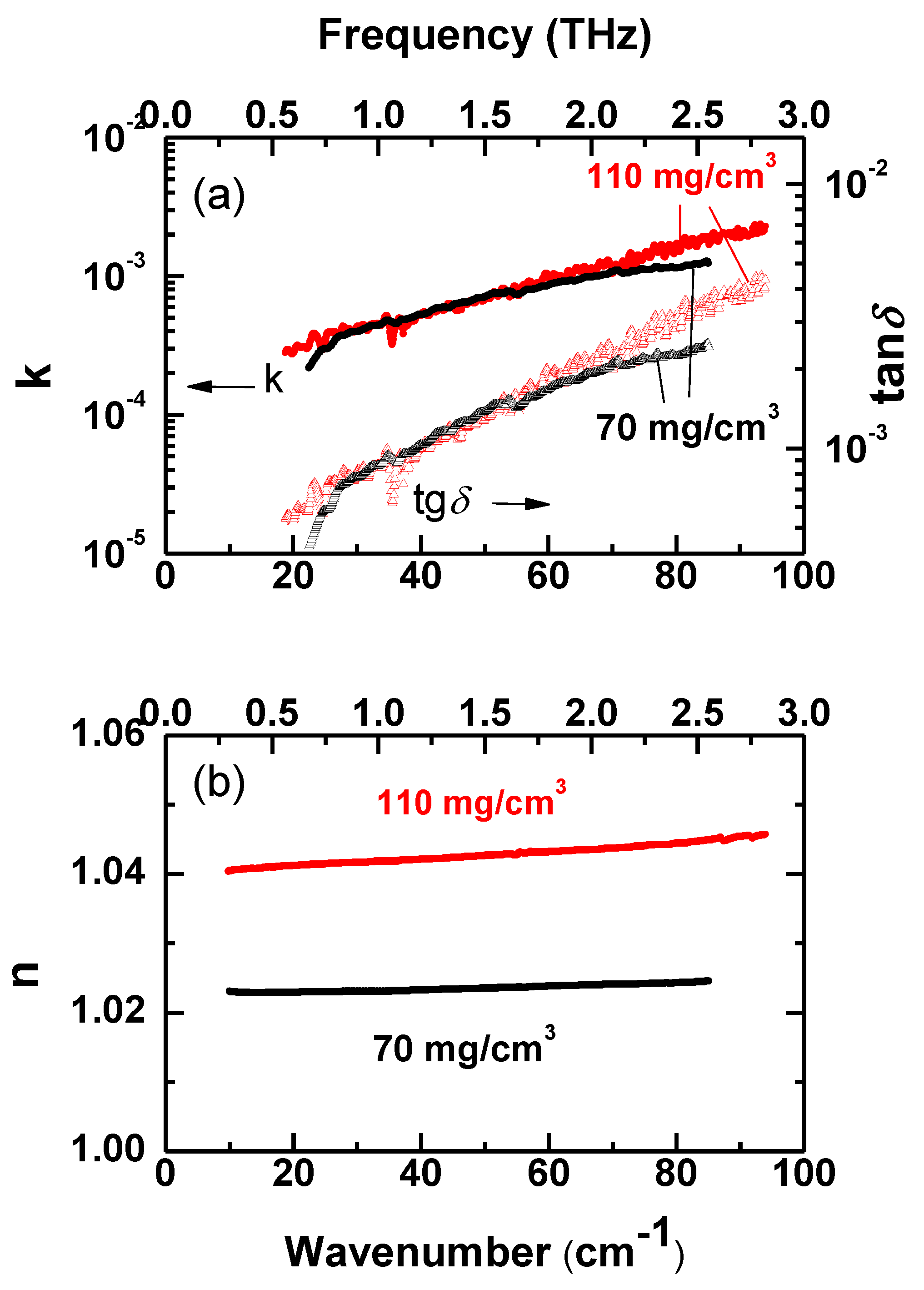
© 2020 by the authors. Licensee MDPI, Basel, Switzerland. This article is an open access article distributed under the terms and conditions of the Creative Commons Attribution (CC BY) license (http://creativecommons.org/licenses/by/4.0/).
Share and Cite
Braniste, T.; Dragoman, M.; Zhukov, S.; Aldrigo, M.; Ciobanu, V.; Iordanescu, S.; Alyabyeva, L.; Fumagalli, F.; Ceccone, G.; Raevschi, S.; et al. Aero-Ga2O3 Nanomaterial Electromagnetically Transparent from Microwaves to Terahertz for Internet of Things Applications. Nanomaterials 2020, 10, 1047. https://doi.org/10.3390/nano10061047
Braniste T, Dragoman M, Zhukov S, Aldrigo M, Ciobanu V, Iordanescu S, Alyabyeva L, Fumagalli F, Ceccone G, Raevschi S, et al. Aero-Ga2O3 Nanomaterial Electromagnetically Transparent from Microwaves to Terahertz for Internet of Things Applications. Nanomaterials. 2020; 10(6):1047. https://doi.org/10.3390/nano10061047
Chicago/Turabian StyleBraniste, Tudor, Mircea Dragoman, Sergey Zhukov, Martino Aldrigo, Vladimir Ciobanu, Sergiu Iordanescu, Liudmila Alyabyeva, Francesco Fumagalli, Giacomo Ceccone, Simion Raevschi, and et al. 2020. "Aero-Ga2O3 Nanomaterial Electromagnetically Transparent from Microwaves to Terahertz for Internet of Things Applications" Nanomaterials 10, no. 6: 1047. https://doi.org/10.3390/nano10061047
APA StyleBraniste, T., Dragoman, M., Zhukov, S., Aldrigo, M., Ciobanu, V., Iordanescu, S., Alyabyeva, L., Fumagalli, F., Ceccone, G., Raevschi, S., Schütt, F., Adelung, R., Colpo, P., Gorshunov, B., & Tiginyanu, I. (2020). Aero-Ga2O3 Nanomaterial Electromagnetically Transparent from Microwaves to Terahertz for Internet of Things Applications. Nanomaterials, 10(6), 1047. https://doi.org/10.3390/nano10061047







